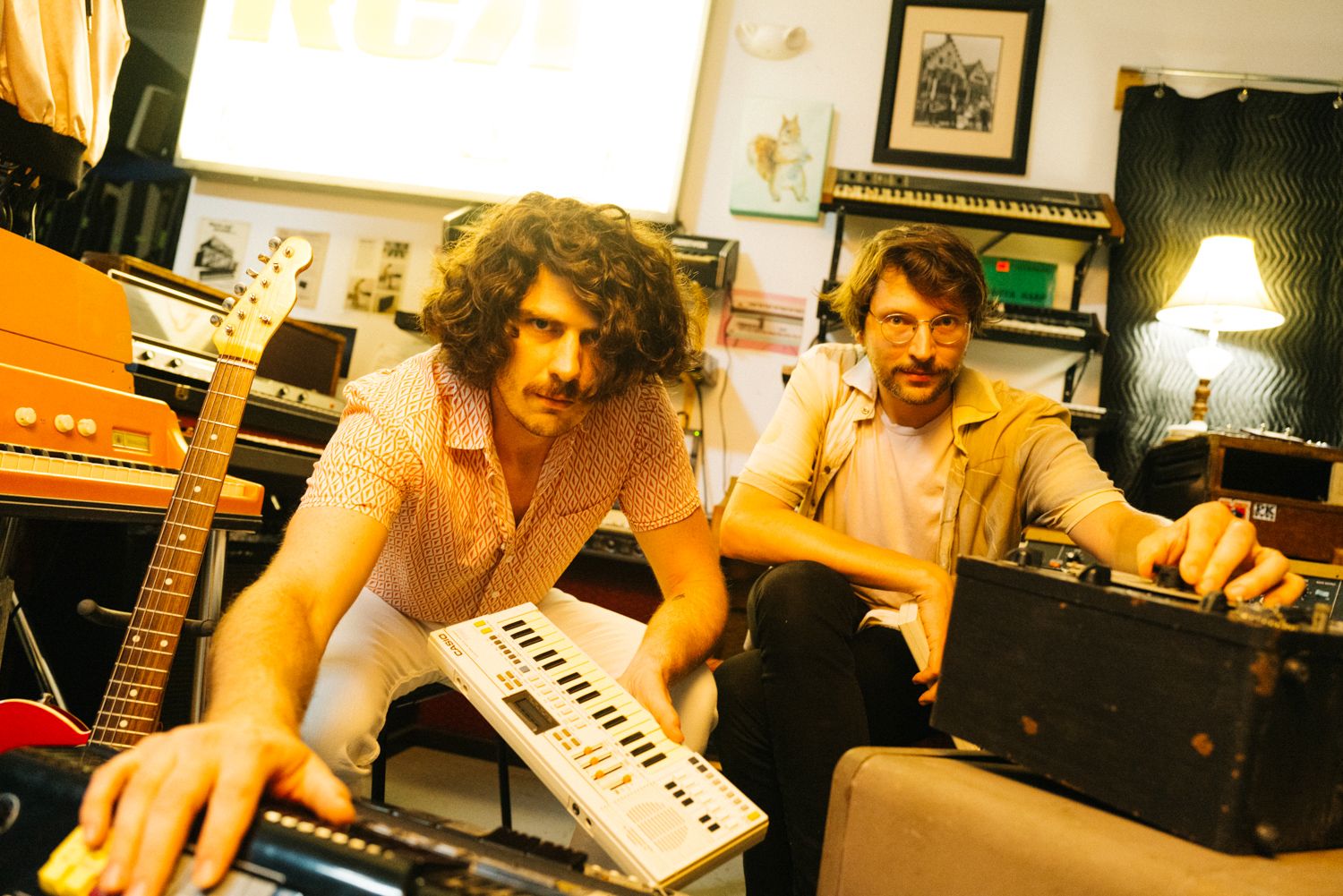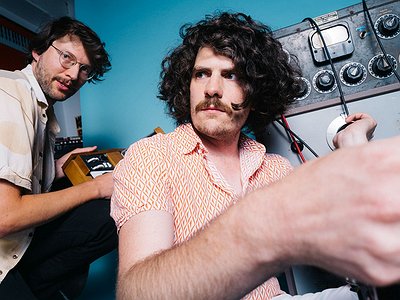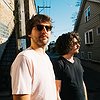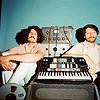Part 1
Name: John Dexter Marston and Mike Franz Novak aka Dexter+Franz
Nationality: American
Current release: Dexter+Franz's Flamingo Heights is out via Nudie or from the Dexter+Franz bandcamp.
Recommendations:
JM: Chuck Close’s portraits have always connected with me for some reason. He seemed to capture the quirkiness of his subject’s personalities in a way that I don’t think most portraits do. I have a print of his “Big Self Portrait” that has been hanging in my house for years.
Also, David Hockney’s photo collage work has always provided inspiration to me on how to use technology in ways that it was not intended and in doing so you can present really unique or even surreal perspectives of the world around you.
Franz: Not sure if this qualifies as art, but I’ve been reading Stephen King’s Dark Tower series. It’s a super compelling story that goes between epic western and sci-fi, and I find it totally immersive.
In the Mood for Love (Wong Karwai, 2000)— a beautifully lush movie that looks and sounds wonderful. I’ve never felt such a sense of yearning and nostalgia from a film.
If you enjoyed this Dexter + Franz interview and would like to find out more about their music, visit them on bandcamp.
Where does the impulse to create something come from for you? What role do often-quoted sources of inspiration like dreams, other forms of art, personal relationships, politics etc play?
Dexter: I’m usually playing music everyday. So it’s more of a habit at this point than an impulse. But I feel I usually get more inspired to create when I listen to a song that a friend made or a I hear a new record or get to use an instrument that is new to me.
Whenever I visit Franz’s studio in Chicago, there is always some new vintage keyboard he has that immediately seems to inspire a chord progression or melody.
For you to get started, do there need to be concrete ideas – or what some have called a 'visualisation' of the finished work? What does the balance between planning and chance look like for you?
Dexter: On Flamingo Heights, there was no grand precognition, not even a plan of making an album. I just always enjoyed spending time in the desert and fantasized about renting a house out there and taking my entire collection of synths, guitars, rhythm boxes, setting them up, and letting the energy of the vast landscape guide my consciousness into channeling some cosmic desert melodies.
Originally the idea was to invite a small group of friends and we would all retreat to this desert house for two weeks and do some kind of free improv ambient thing. It sounded magical in my head. After floating the idea out to some friends, I got lots of interest, but Franz was the only one to commit.
In the end I think it was much better that it was just the two of us because it helped us focus on a more cohesive direction during our sessions.
Franz: Improvisation guided the desert sessions that became the album. The title track “Flamingo Heights” was the starting point that shaped the direction for the rest of our time in the desert.
Dexter and I found a flow that enabled our creativity, usually starting with a more composed idea and ending with long form ambient jams that were post-composed into digestible songs.
Is there a preparation phase for your process? Do you require your tools to be laid out in a particular way, for example, do you need to do 'research' or create 'early versions'?
Dexter: Because Franz and I live in different cities (he’s in Chicago and I’m in Los Angeles) we have to be quick and efficient during our recording sessions.
We usually spend time at the beginning of the session setting up our sandbox: 3 or 4 synths / keyboards, a drum machine, a DI for guitar or bass and then a mic for anything acoustic like guitar or hand percussion. That feeds into 8 channels on a mixer which goes into either an Otari MX5050 tape machine or Pro Tools.
Once the sandbox is set up we can just hit record and freely move between different instruments.
Franz: Once we have the rig ready, its easy to jump around between instruments and get the ideas flowing. Our process is very open minded and improvisational. There were really no expectations going into our session in the California desert, and we came out with something fresh and exciting for both of us.
I think now we have a better idea of how to get to that place and will trade demos, but a lot of the magic comes from spontaneous ideas sparked by our surroundings or the instruments available.
Do you have certain rituals to get you into the right mindset for creating? What role do certain foods or stimulants like coffee, lighting, scents, exercise or reading poetry play?
Dexter: I started getting into burning incense during the mixing phase on Flamingo Heights. I feel like the incense helped to channel elements of the natural world while listening from the comfort of my urban studio.
Franz: I experimented with small (micro) doses of mushrooms during our recording sessions. Hard to say how much impact that made, but it’s a nice ritual. That and a glass of mezcal in the evening gets me in a good spot.
Going for at least one walk during the day helps keep things refreshed.
Dexter+Franz Interview Image (c) the artists
What do you start with? And, to quote a question by the great Bruce Duffie: When you come up with a musical idea, have you created the idea or have you discovered the idea?
Dexter: Usually a chord progression, something we stumble on from just jamming together on a couple of synths. Although lately, we’ve been starting more on the acoustic guitar.
Nothing comes out perfect the first time. Usually one of us might take the lead and come up with an A section and a B section for a song. Then the other person will act as kind of an editor and suggest some sort of new element. It could be a change of instrumentation, chord modulation or maybe a new melody.
But that’s where the real magic happens because the song does an unexpected thing now that someone else’s brain has guided it in a new direction from its origin. This is more or less how “Cermack Run” came about.
I had an A section chord progression on acoustic guitar, but didn’t know where it should go. Franz worked out a spot where we should modulate and then once that happened, the rest of the song just fell into place within a few hours.
Franz: I like the concept of “discovering an idea”! One of the songs I feel I took the lead on is “Plant Talkers”.
The main chord progressing came from my day-to-day tinkering with electric pianos (my day job is restoration of vintage electric pianos), but once adapted to Dexter’s Moog One synthesizer it took on a whole new dimension. After we worked out the structure, the direction became clear and things came together quickly.
Many writers have claimed that as soon as they enter into the process, certain aspects of the narrative are out of their hands. Do you like to keep strict control or is there a sense of following things where they lead you?
Dexter: After our initial recordings in the desert, Franz went home to Chicago and I went back to Los Angeles. Over email, we would talk about getting other musicians in to add overdubs, like drums, saxophone and pedal steel. I was able to visit Chicago for a week and we recorded all the drums in Franz’s studio with Justin Peters. But then I had to go home again let Franz oversee the rest of the overdubs.
Even though I wasn’t there, Franz and I share a lot in common taste-wise, so I think that helped me let go and just trust that things would turn out great. I remember getting the “Nightshade” mix back with the pedal steel overdubs and being blown away. It added this layer of cosmic melody that really helped to elevate the song.
Franz: I like that we can trust each other with this project! I think the songs pave the narrative path, and we just answer the call and follow where it leads.








